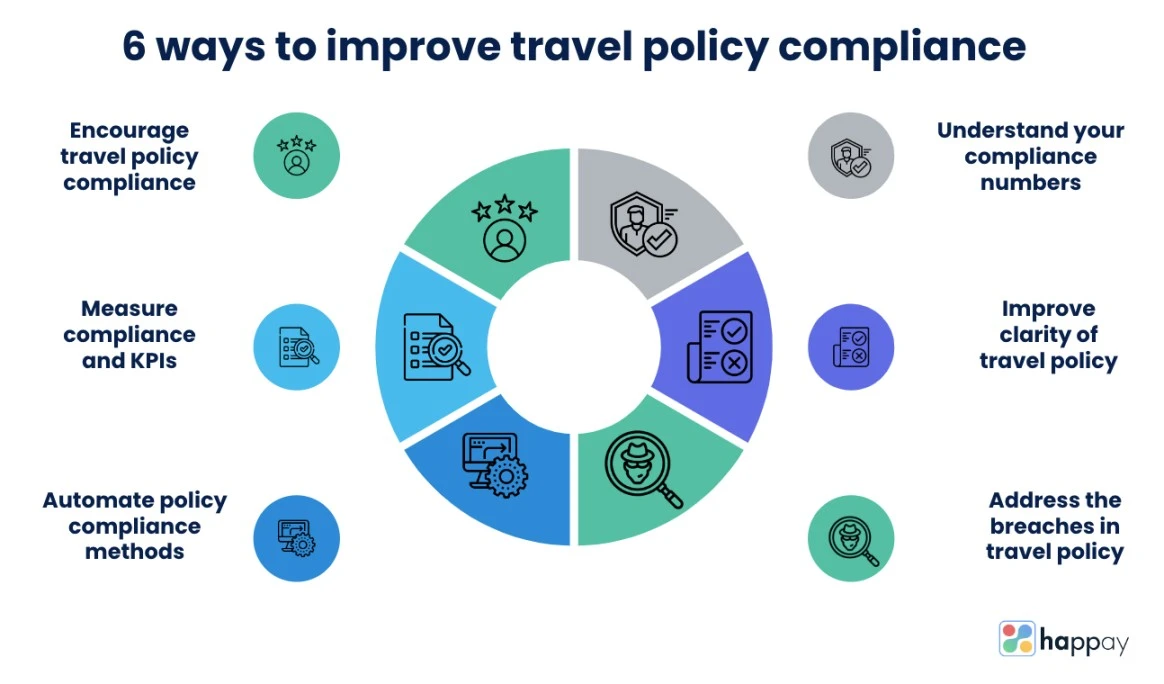Last Updated on November 28, 2025
Travel policy compliance
As someone rightly said, it takes less time to do things right than to explain why you did them wrong!
It works the same way with travel policy compliance. It takes a lot longer to go through transactions and rectify mistakes than to understand and stick to the policy guidelines in the first place.
According to research, 60% of business travelers don’t understand their company’s travel policy, and only 50% follow the policy guidelines.
So, what can you do to improve travel policy compliance in your workplace?

1. Understand your travel policy compliance numbers
Travel policy compliance is about adhering to the guidelines mentioned in the company’s travel and expense policy. The norms and procedures in the travel policy serve as a guide for employees as they travel for work. Generally, travel and expense policies lay down rules regarding every form of travel (domestic and international), flight classes, travel period, accommodation, etc.
Some of the things covered in these policies are
- Name and other necessary details of the travel management company.
- The reimbursement system (including details of expense report submissions, time for settlement, etc.).
- Limitations on business expenses (the permissible limits for flights, trains, hotels, restaurants, cab services, etc.).
- Approval hierarchies within the organization (approval of expenses or extension of the same).
1.1 Why do travel policy compliance matter?
It matters because businesses have limited resources. Besides restricting business travel expenses, travel policies advocate rules that ensure employee safety, budget planning and management, and streamlining travel arrangement processes.
1.1.a Employee’s focus remains on the job
When employees initiate business trips, it is primarily to engage with the company’s customers or to further the business objective in any other way. Having a travel policy allows them to focus on the task at hand.
So, as they focus on getting ready for their work trip, the company’s travel desk or the designated travel management company makes reservations and plans the business trips. On the other hand, you may employ expense management software or a self-booking tool to speed up the travel booking workflow.
Such arrangements are far more manageable than employees going through the booking process independently.
1.1.b Cost saving
Isn’t it like asking a child to color within the lines of a coloring book?!
By providing your employees with guidelines, you are ensuring that employees spend only within the permissible limits. It not only allows you to budget for business expenses, but it also saves your business money.
Manual expense management solutions may work, but you need more visibility to budget or plan your expenses. On the other hand, automated expense management solutions encourage cost savings while offering sharp insights into the company’s spend.
Plus, the software equips you to enforce your policies even before employees set off on their trip. Since the travel policies are inbuilt, systems flag off any violation ensuring the employees stick to the pre-determined budget.
1.2 Employee’s role
As per a report published in the travel daily news, research was conducted by the Global Business Travel Association on the state of the business and projected travel in the year 2022. Compliance enforcement stood right on top of the poll conducted. 60% of travel managers (in the US and Canada) felt that getting their employees to comply with travel policies is challenging for their companies.
So, what is an employee’s role in travel policy compliance?
As an employee, your responsibility lies in ensuring you are aware of and follow the guidelines and the processes appropriately. Further, since you experience everything first-hand, your suggestions can go a long way in improving the process. So, ensure your feedback is registered and recorded.
1.3 Employer’s role
1.3.a Educate
Ask your employees when was the last time they read the travel and expense policies. If the answer is during onboarding, it’s time for some changes.
For efficient travel policy compliance, you must ensure that your employees can access and understand the guidelines. While new employees must be aware of the policies and procedures, regular refresher programs for all employees are critical. Further, managers, approvers, and other authorities must be part of this education process.
The policies must be available on your company’s intranet and easily accessible on the travel portal everyone uses. If your organization uses a software tool, make sure the policies are built (including policy changes) into the system. All traveling employees must receive an email or intimation of the rules before every business trip.
Apart from educating the employees about the policies, you must clearly define and communicate the consequences of non-compliance.
A sure-shot way to ensure 100% policy compliance is to automate travel and expense workflows. Happay’s travel software redefines T&E management for you. For instance, the system has a pre-spend feature that encourages responsible spend behavior among your employees.
When employees use the app to initiate a travel booking, any out-of-policy flights or hotels will be automatically flagged off. You may customize such blocks to allow employees to proceed with the booking (after notification), or you can design the system to only show options available within the permissible limits.
1.3.b Communicate
According to several studies by GBTA (Global Business Travel Association), there needs to be a better understanding of travel policies. Further, research shows that business managers assume that their employees know and understand their organization’s travel and expense policies.
Employees have the organization’s best interests in business travel. Without a proper understanding of the travel and expense policies, they will continue to use their best judgment, costing your business money. Excellent communication is the key to travel policy compliance.
Any policy changes must be communicated through the channels most often used in your business. Besides regularly informing your employees about travel policies, make travel policy education an integral part of the onboarding process (especially for traveling employees).
You are nudging your employees towards travel and expense policy compliance by empowering them with the information.
Suggested Read: A Guide to Business Travel Management
2. Improve clarity on travel policy guidelines
For travel policy compliance, your employees must understand the guidelines. So, here’s the first question you must ask yourself. How easy is it to understand your travel and expense policy?
To simplify your travel and expense policy, start by reviewing it to assess how easy or hard it is for your employees to understand the rules.
You can accomplish this through feedback sessions or a committee (with employees who travel often) that can provide recommendations on the same.
Suppose you still need to get a travel policy in place. Consider choosing between a detailed (where every tiny detail is covered) and a broad approach (mentioning only the general principle) before writing a travel policy. Each of these approaches has its pros and cons.
For instance, if you choose a detailed approach, employees may find it too voluminous and skip reading a few portions. On the other hand, covering just the broader aspects may make things ambiguous for employees.
Suggested Read: The Business Guide to Corporate Travel Program
3. Address breaches in travel policy compliance
3.1 Expense fraud – unintentional or intentional breaches
Non-compliance with travel and expense policies is an issue all businesses face. Intentional or unintentional, you must address the case at the earliest.
According to a study on expense fraud, 37% of the employees admitted to rounding off mileage fees, of which 22% have done so intentionally and 15% unintentionally.
Generally, employees do not intend to claim in excess. However, a combination of reasons may cause such claims. For instance, if the rule is unclear, employees may claim expenses according to convenience.
Intentional non-compliance is clearly a category of expense fraud. Generally, when companies discover such deception, they deal with it quite severely.
However, it is also essential to understand the reason for such non-compliance. To encourage travel and expense policy compliance, you must explore the reasons for such fraud.
Here are some reasons.
- Employees may feel that padding claims for personal benefit would compensate them for overtime that the organization did not pay them.
- Employees may find such compensation valid for personal money and time spent on business trips.
- Finally, employees may feel their current compensation is not adequate.
Making employees aware of such issues is critical to improving travel policy compliance. Apart from mentioning the non-compliance issues, you must communicate the guidelines consistently and clearly.
Also, Read: Travel and Expense Report
4. Eliminate manual travel policy compliance measures.
Did you know that you can fix travel policy compliance and cost leakage due to non-compliant claims by investing in the right technology?
Happay has the perfect answer when it comes to overcoming problems of travel and expense non-compliance. Happay offers travel and expense software providing a complete, cloud-based interface that promises to address cost leakages due to
- Expenses out of permissible limits
- Out-of-policy mistakes in claims
- Amount mismatches
- Duplicate bills
- Mileage frauds
- Cost leakages due to no real-time spend visibility
Happay’s customizable expense management software incorporates your travel policies into the system’s architecture, ensuring that any policy violations are flagged off. It encourages employees to abide by the guidelines while allowing them to bypass the same (with approvals) as they initiate travel requests.
Alerts and other notifications can be based on travel policies and existing approval hierarchies.
The advantages that technology can provide for employers and employees are:
4.1 Self-booking
Self-booking tools allow employees to plan business trips according to their convenience and stay compliant. When you build the policies into the system’s architecture, travelers enjoy the freedom of planning the itinerary and travel experience.
4.2 Easy Interface
A simple and well-designed interface can dramatically improve the employee experience. Travel software that allows employees to navigate the options (within the rules and guidelines specific to them) saves time and effort. Plus, as an employer, all the data the software compiles can be the basis for better spend analysis and reporting.
4.3 Built-in policy controls
Travel policy compliance will improve when you customize the policies you want to build into the system’s architecture. You can pay attention to some things, such as
- Departments that often travel.
- You may want to devise policies for those that travel on short notice.
- Work out a budget for more-expensive routes.
- You can work on a differential rate for executives in different classes and incorporate the same into the booking tool.
Quick Read: A Guide to Manage Business Travel Spending
5. Measure travel policy compliance and key parameters
5.1 Measuring compliance
You can use several KPIs (key performance indicators) to measure travel policy compliance. However, it works best when the process is automated, as you can capture data and information at every point. You can compile and analyze the information quickly and efficiently.
On the other hand, when employees book business trips in the open market, the process is long-drawn. Therefore, you must measure and monitor all stages to understand if the booking is within the policy, was done well in advance, and the expense reports are valid and authentic.
Travel policy compliance is directly related to employee satisfaction. Therefore, measuring employee experience is absolutely critical. If employees find the policies inconvenient or confusing, it is more likely that your policy compliance numbers will drop.
5.2 Analyze your current policy
Travel policies must be reviewed and edited to suit your organization’s needs. Ensure the guidelines are simple and drafted in an easy-to-understand manner. Corporate travel management is about equipping your employees with information that will help them make the right choices when it comes to business travel.
Sometimes, explaining the reasons behind specific policies results in better compliance as employees understand its rationale.
5.3 When is it time to update your policy?
While it is essential to revisit your policies constantly, you must update them when necessary. Here are some occasions when you must consider updating your policies.
- Growing organization or a change in organization structure
- Employee feedback suggests there is a need for change
- Policy compliance is a concern
- Employees not using company-approved travel managers but other tools.
Also, Read: A Guide to Creating a Corporate Travel Policy
6. Encourage travel policy compliance
6.1 Use technology for better travel policy compliance
Spend management software has a massive role in encouraging travel policy compliance.
Businesses are unique, and so are the travel policies they use. What companies need is a technology that works according to their needs. Not only is the technology extremely flexible to suit businesses and their unique requirements, but it simultaneously eliminates the possibility of non-compliant expense claims almost immediately.
So, how will it work?
- You can begin by defining your travel policy to cover all travelers (if it still needs to be implemented). Categorize them conveniently as field force (road), executives, sales personnel, and occasional travelers.
- Next, you must detail your organization’s approval workflows and hierarchy. Cover these extensively and clearly if you have multilevel approvals or other features.
Considering new technologies ensures your workflows are straightforward, gives your employees a superior travel experience, and helps travel and expense policy compliance.
Some businesses may opt for TMCs (travel management companies) that use such technologies.
Others may consider investing in corporate booking tools that ease the planning process (with policy compliance), and some others may look for vendors offering integrated travel management systems.
Suggested Read: 10 Best Travel Management Software
6.2 Employee experience and Travel Policy Compliance go hand in hand
According to Monica Sanchez, Director (Research) of GBTA (Global Business Travel Association) Foundation, travel managers must use technology to balance the well-being and satisfaction of travelers along with other cost-saving priorities.
According to a study released by the GBTA Foundation, over 70% of Latin and North American travel managers indicated that travelers’ well-being was a significant factor when employees considered aspects of their company’s travel policy.
Your employees’ booking and travel experience can significantly influence travel policy compliance. Improving the booking and traveling experience motivates employees to comply with your policies.
So, how can you accomplish this?
- Ask your employees for feedback as they list their challenges with the existing travel process. Use this to modify the current policies or shape future guidelines.
- Self-booking tools (with in-built policies) can make travel planning easy for employees. These booking tools (layered with AI) can offer personal preferences (within the policy) based on employee choices. Automate the travel process, as this can instantly transform the workflows to make it smooth and more efficient.
- Such automation can also give you access to data through reports. The analyses can lead to a better understanding of the process and the lack thereof, allowing you to make the necessary changes.
6.3 Thinking out-of-the-box helps
Like every other other challenge, you may need to think out of the box to solve the problem of travel policy compliance.
For instance, how about putting employees on a simple watch list for a short period? Closely monitor their travel booking, plans, claims, and other related information. Once they assure the company they know the policies, they may move out of the list.
Another way to motivate employees is to offer incentives. For example, employees booking lower fares may be given points or will be eligible for a higher fare at some point. It casually nudges people towards travel and expense policy compliance. Some businesses are also attempting to gamify the travel policy compliance process.
While the results of such an attempt are still out there, being creative is bound to get you results.
Also, Read: A Guide to Travel Expense Reimbursement Process
How can Happay make you 100% policy compliant?
Did you know that your finance team is three times less productive due to policy non-compliance issues? Is 100% policy compliance possible?
Yes, it is possible, and you can do it with Happay.
Happay accomplishes this by automating the four pillars of expense management
- Data capture – Most expense receipts are now available digitally. So, either through emails, SMS, credit card statements, travel apps, bills, or WhatsApp, data can be captured automatically.
- Processes – When you automate processes, you can restrict violations by validating them before the employees incur the expense. For example, the system flags off claims during flight or hotel booking, expense filing, per diem rates, etc.
- Approvals – There are several ways to automate the approval process. For instance, you can auto-approve expenses that have no policy violations. On the other hand, you can easily incorporate deviation workflows to accommodate certain specific scenarios.
- Expense auditing – Finally, you can identify unique policy violations or filter just the out-of-policy violations. It is also possible to find duplicate expenses.
Schedule a demo to find out how we can improve your travel policy compliance numbers.
Conclusion
As business travel trends evolve, employees expect freedom and better travel experiences. If you pay attention to your travel policy, review them often, update it, and ensure your employees are well informed, you are on the right track. Also, by automating, you can offer a better travel experience and ensure that your travel compliance numbers improve.
FAQs
Travel compliance refers to the act of employees sticking to the guidelines provided for business travel. Ideally, the policies must cover everything, such as permissible limits for travel fares, a list of approved accommodations, cab fares, fuel reimbursements, etc.
Drafting a travel policy is crucial to ensure that your employees have a comfortable travel experience while your company saves money. You can begin by
a) Always using the employee’s perspective as a starting point before you draft the policy.
b) Create a policy that is comprehensive yet simple to understand.
c) Keep it flexible so you can modify it based on employee feedback.
d) Create and encourage employees to provide feedback so you can constantly update the process.
e) Consider including a duty-of-care plan within the policy.
Duty of care is a primary obligation of all organizations to ensure that employees who travel for work do so safely and comfortably. The travel and expense policy must mention rules and procedures for the same.
In simple terms, following company travel policies keeps things easy for employers and employees. Employees can focus on the work, while employers can assure themselves that actual expenses will match the projections.
The best way to ensure travel policy compliance is to focus on the employee experience. As you improve the employee’s travel experience.










Discussion about this post